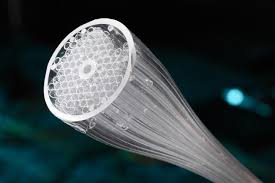The future of the internet may not lie in more powerful servers or bigger data centers, but in a strand of glass that is—ironically—mostly empty. Scientists at the University of Southampton have developed a radical new hollow-core optical fiber that carries light through air instead of solid glass. The result? Data that moves faster, farther, and with a thousand times more transmission power than today’s networks can handle.
This isn’t just a tweak to existing fiber optics—it’s a potential upheaval in how the world moves information.
Conventional fibers force light to crawl through solid glass, bleeding signal strength every 15 to 20 kilometers. That’s why our global internet backbone depends on endless relay stations to catch weakened signals and push them forward again. The new hollow design extends that distance to about 33 kilometers before losing half its signal. In practical terms, that means you could skip every second or third building in the global chain of repeaters, saving billions in infrastructure costs while massively improving speed.
The physics are simple but stunning. Light travels about 45 percent faster in air than in glass. By guiding it through a hollow lattice of microscopic air channels, these fibers deliver unprecedented efficiency. Researchers have even shown that the fibers can carry single-photon pulses—critical for the coming era of quantum communication—while simultaneously handling classical internet traffic. In one stroke, this technology could bridge today’s networks with tomorrow’s quantum-secure infrastructure.
The design itself is elegant: a large cylinder lined with five smaller cylinders, each containing two nested channels. This precise geometry corrals light waves inside the hollow core, preventing them from scattering or leaking out. Lead researcher Francesco Poletti, who has spent more than a decade refining the concept, calls the result “transformative.” He may be understating it.
Manufacturing such delicate structures at scale has always been the stumbling block. Traditional optical fibers are made by melting and stretching solid glass, but hollow fibers demand a different process. The Southampton team begins with a massive glass preform already embedded with hollow channels, then carefully stretches it down to hair-thin strands while pressurizing the voids to preserve their shape. The result is a robust, scalable product ready for the real world.
And the real world is waiting. Microsoft underscored the stakes in 2022 when it acquired Lumenisity, the Southampton spinout commercializing the technology. With cloud giants desperate for more bandwidth and governments pouring resources into quantum communication, hollow-core fibers could quickly move from the lab into undersea cables, metropolitan grids, and even home connections.
The implications go beyond faster Netflix or smoother Zoom calls. If this technology scales, it could cut the cost of global internet infrastructure, accelerate AI training by reducing latency between data centers, and enable secure, quantum-resistant communication for governments and financial institutions. It’s not just a faster highway for data—it’s a new road altogether, built for both the internet we know and the quantum internet on the horizon.
What’s most provocative is the symbolism: a future where emptiness, not density, carries the most value. In a world obsessed with more—more servers, more processing, more storage—the next great leap in connectivity might be found in something that is, at its core, hollow.
For further reading:
- Microsoft bets on hollow-core fiber for next-gen networks
- How hollow fibers are bringing quantum communication closer to reality


